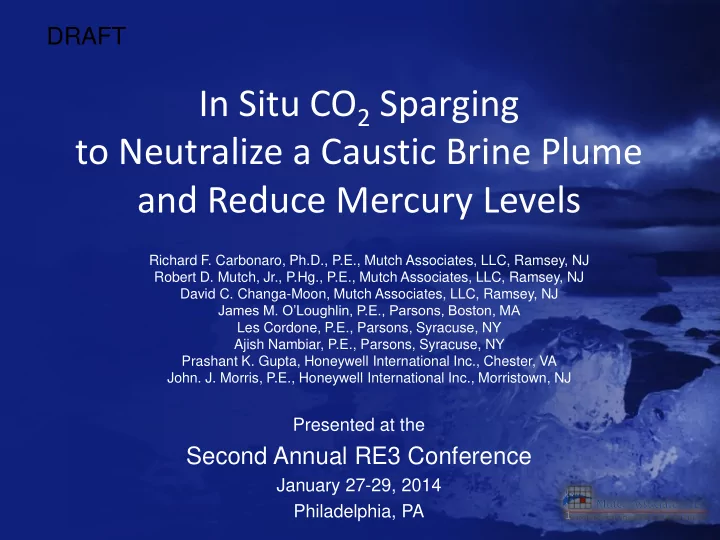

DRAFT In Situ CO 2 Sparging to Neutralize a Caustic Brine Plume and Reduce Mercury Levels Richard F. Carbonaro, Ph.D., P.E., Mutch Associates, LLC, Ramsey, NJ Robert D. Mutch, Jr., P.Hg., P.E., Mutch Associates, LLC, Ramsey, NJ David C. Changa-Moon, Mutch Associates, LLC, Ramsey, NJ James M. O’Loughlin, P.E., Parsons, Boston, MA Les Cordone, P.E., Parsons, Syracuse, NY Ajish Nambiar, P.E., Parsons, Syracuse, NY Prashant K. Gupta, Honeywell International Inc., Chester, VA John. J. Morris, P.E., Honeywell International Inc., Morristown, NJ Presented at the Second Annual RE3 Conference January 27-29, 2014 Philadelphia, PA 1
Site Background • Former chlor-alkali facility • “Caustic Brine Plume” − Depth: 25 to 50 feet bgs − pH>10.5; typically 11 to 12 − Specific gravity: 1.02-1.05 − TDS: 30,000 to 60,000 mg/L − Mercury: 50 to 1000 μ g/L − Silica: 50 to 17,000 mg/L
CO 2 Sparging Concept 3
CO 2 Sparging Lab Study Lab Study Objectives: Determine the pH response of CBP water upon sparging with CO 2 (g) Assess the extent of solids production upon pH adjustment with CO 2 (g) Determine the effect of CO 2 (g) sparging on dissolved metal concentrations.
CO 2 Titration Curves Sparging Duration (sec.)
Proof of Concept Test Area Proof of Concept Test Area
Proof of Concept Test: Plan View 7
Pre-Sparge pH and Hg 8
CO 2 Delivery Sparge well (SW-1) CO 2 Trailer Vaporizer 9
Sparge Well Flow Control Valve Pressure Gage Flow Meter Sparge well (SW-1) 10
Monitoring Well Network Each monitoring well also equipped with a Solinst Levelogger TM to continuously monitor water levels Sparge well Monitoring wells with extensions Hach continuous-recording pH electrodes and meter 11
Typical pH Response in Monitoring Wells 12
Typical Response of Deep, Middle, and Shallow Well Potentiometric Surface 13
Maximum Level of Groundwater Table in Shallow Satilla Aquifer during Sparging 14
pH after Two Weeks of Sparging into SW-1 15
pH after a Third Week of Sparging into MW-1C 16
Mercury/pH Relationship 17
Long-term Monitoring Results: pH 18
Long-term Monitoring Results: Hg 19
Conclusions of Proof of Concept Test • The pH of the CBP within a radial distance of at least 20 feet could be reduced to 6.5-7.0 within 7 days of sparging (8 hrs./day) at approximately 50 scfm − A radius of influence of at least 20 feet was achieved at the top of the CBP (approximately 30 ft bgs) and greater than 60 feet at the water table • Mercury levels declined from 110-120 ug/L to 11-33 ug/L (70 to 90% reductions) two weeks after the sparging • Significant mounding of potentiometric surfaces was observed, particularly in the deep wells. − The piezometric surface in the deep wells rose 3 to 4 feet above ground surface. At its highest, the groundwater table rose to within about one foot of the surface. 20
Recommend
More recommend